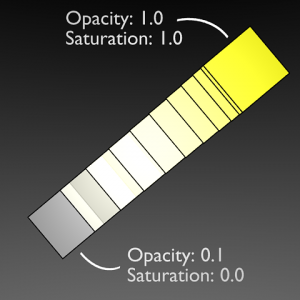Dev:Source/Modifiers/Object Modifiers
NOTE
This document is under construction. More information about the proposed feature set will be available pending further discussion.
|
Introduction
The Modifier Stack (1,2) provides Blender users with a powerful set of tools for non-destructive mesh editing. Between the recent addition of the Array Modifier and the Mirror Modifier, many potentially time consuming operations have been made obsolete. Recently, however, the point has been raised there are other features in Blender which could stand to benefit from such an interface. DupliFrames, DupliVerts and Particle Duplicators all offer similar functionality to the Array Modifier, but aren't available in an interface that is as versatile and easy to use the Modifier Stack. Object Modifiers have been proposed to extend this useful and flexible design metaphor even further, thus providied a unified and consistent approach to non-destructive editing across Blender's user interface.
Proposed Modifiers
During intitial discussion of this proposed feature set it quickly became apparent that a small number of mesh-editing modifiers (herein referred to as Mesh Modifiers) could be carried over to an Object Modifier Stack, giving users numerous additional options to expand on their artistic freedom. Not only would reuse of these modifiers allow for quick adoption by existing users, but it would facilitate education about both Mesh Modifiers and Object Modifiers for new users. Numerous potential modifiers have already been discussed, the majority of which are listed below:
- DupliVerts
- DupliFrames
- DupliMats
- Mirror
- "Onion Skin"/Ghosting
- Array
While this is not a complete list, it will not be long before additional modifiers are proposed. This initial set should give the reader an insight into the type of functionality which will be covered by Object Modifiers. A more detailed explanation of these modifiers can be found below.
"Onion Skin"/Ghosting
This proposed modifier would behave in a manner similar to the DupliFrames Object Modifier, displaying instances of an object for frames other than the current frame. However, the primary difference between the two functions is that unlike the DupliFrames function, this new feature would allow the user to specify a number of frames prior to and following the current frame, between which all frames would be displayed. An example of a use for this feature is illustrated in Fig. 1 would be to create a "trailing shadow" effect behind an animated object in which n instances of the original object are displayed, one for each of the previous n frames at the location it occupied in that frame.
It should be noted that the most desireable use of this feature would be in conjunction with control over material settings e.g. the opacity of an object decreasing as the offset between the current frame and the n-th frame increases. It is possible that this functionality would be made available in connection with "DupliMats" but it isn't yet clear if this will be the case.
Desoto 04:23, 14 August 2006 (CEST)
